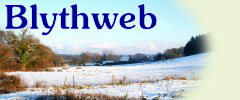Writing About Blythburgh History: A Select Bibliography
Few people would question the need for scientists or engineers, engaged upon new projects, to keep abreast of the development of knowledge and thinking within their subjects. It is less generally understood that an equivalent requirement applies to historical writing. Too often discredited interpretations are repeated and perpetuated uncritically.
‘Facts’ and ‘Truth’ are not very helpful words. Written history is an interpretation of evidence and therefore uncertain. Interpretation should be rigorous but it will always be open to review as more information becomes available. Evidence must be looked at carefully - ‘Artists’ impressions’ are often just that, reality may have been adjusted for effect. People often wrote with a particular audience in mind, and to represent themselves in a good light. And we all know how fallible are newspaper reports.
There is nevertheless some good reading available on Blythburgh history. Together with the study of Directories (1793 onwards) these suggestions will help to separate history from mystery!
- Timothy Beardsworth, ‘The flint-work inscription under the east window of Blythburgh church’ Proceedings of the Suffolk Institute of Archaeology and History, XXXVIII (1993)
- M. Janet Becker, Blythburgh, (Halesworth, 1935)
- Martin Carver, The Age of Sutton Hoo, (Woodbridge, 1992)
- H. Munro Cautley, Suffolk Churches, (5th ed. Woodbridge, 1982)
- J. B. Clare, Wenhaston and Bulcamp, Suffolk, (Halesworth, 1903)
- David Dymond and Edward Martin (eds), An Historical Atlas of Suffolk, (Ipswich, 1988)
- David Dymond and Peter Northeast, A History of Suffolk, (2nd ed. Chichester, 1995)
- David Dymond and Roger Virgoe, ‘The Reduced Population and Wealth of early Fifteenth–Century Suffolk’ , Proceedings of the Suffolk Institute of Archaeology and History, XXXVI (1986)
- Thomas Gardner, An Historical Account of Dunwich, Blithburgh and Southwold, (London, 1754)
- G. L. Gomme (ed.), Topographical History of Staffordshire and Suffolk, (London, 1899)
- C. Harper-Bill (ed.), Blythburgh Priory Cartulary, (2 vols, Woodbridge, 1980 and 1981)
- Birkin Haward, Suffolk Medieval Church Arcades, (Ipswich, 1993)
- Lord Francis Hervey (ed.), Suffolk in the Seventeenth Century, (London, 1902)
- John Kirby, The Suffolk Traveller, (2nd ed. London, 1764)
- Rachel Lawrence, Southwold River, (Exeter, 1990; new edn. Southwold, 1997).
- D. MacCulloch, Suffolk and the Tudors (Oxford, 1986)
- Judith Middleton-Stewart, Inward Purity and Outward Splendour: Death and Remembrance in the Deanery of Dunwich, Suffolk, 1370-1547,(Woodbridge, 2001)
- J. W. Newby, The Patrick Stead Hospital ... with notes on the Blythburgh and District Hospital, (Halesworth, 1964)
- Colin Richmond, John Hopton. A Fifteenth-Century Suffolk Gentleman, (Cambridge, 1981)
- Norman Scarfe, Suffolk in the Middle Ages, (Woodbridge, 1986); The Suffolk Landscape, (London, 1972)
- John Shaw, ‘The Finance and Construction of the East Anglian Houses of Industry’, Proceedings of the Suffolk Institute of Archaeology and History, XXXVII (1992)
- The Rev. Alfred Suckling, The History and Antiquities of the Hundreds of Blything and part of Lothingland, (London, 1847)
- Peter Warner, Greens, Commons and Clayland Colonization. The Origins and Development of Green–side Settlement in East Suffolk, (Leicester, 1987), and The Origins of Suffolk,(Manchester, 1996); Bloody Marsh: A Seventeenth–Century Village in Crisis, (Macclesfield, 2000)
- Arthur Young, General View of the Agriculture of the County of Suffolk, (London, 1813, facsimile 1969)
- A Survey of Suffolk Parish History, (Ipswich, 1990)
Alan Mackley, Blythburgh, rev. July 2001
Back to the History Index
Some Favourite Websites For December 2025:
The Halesworth Pet Store – Specialists in Animal Nutrition and Pet Care
Visit our shop or take advantage of our Free Local Delivery Service! We are experts in animal nutrition, catering for all quantities – from small bags to bulk deliveries amd we are happy to help with all of your requirements
Valley Farm – A large family farmhouse in Walberswick
A Grade II listed farmhouse for up to 11, plus 2 cots, with amazing views across the marshes to the sea.
Singtong Neeyom Thai Restaurant – Delicious authentic Thai Cuisine
Take a look at Singtong Neeyom Thai Restaurant in the centre of Halesworth, for a range of delicious and skillfully prepared Thai dishes created by their own native Thai, Piek.
The Southwold Railway Trust Shop – For all sorts of quirky souvenirs of the Southwold Railway
The Southwold Railway shop fully supports the Southwold Railway, it's Trust and the Steamworks attraction in Southwold. The Southwold Railway was a 3ft gauge line running 9 miles between Halesworth and Southwold. The Trust was formed in 1994
Stoneware Birds – Life-sized handmade and unique British birds, now available to buy online.
A charming unique gift or a treat for oneself. See the website to know how each one is made. Now available to buy online. Each bird is an individual creation, varying in choice from the perky wren to the plump bullfinch together with other well-loved British birds. Which will you choose?
